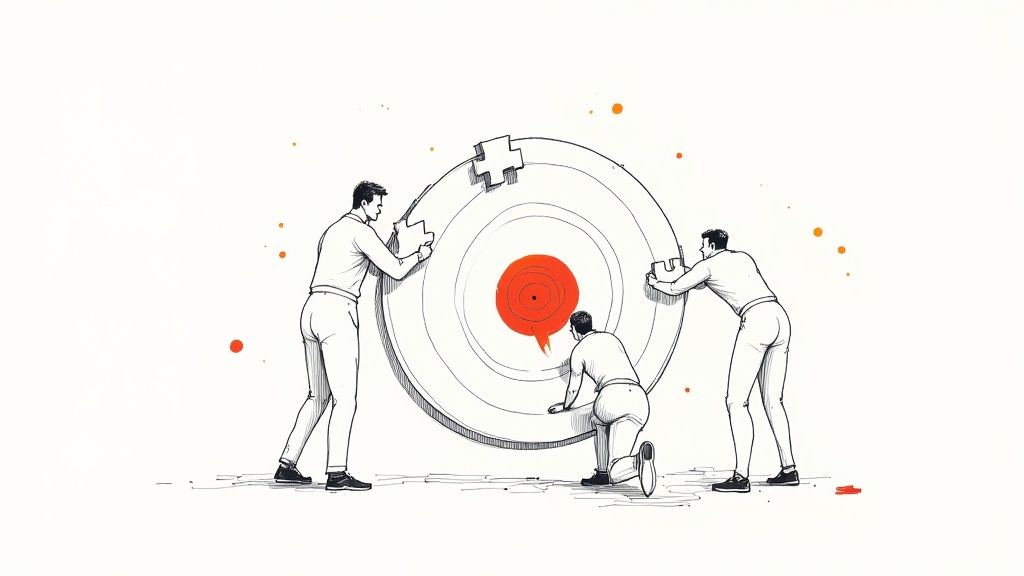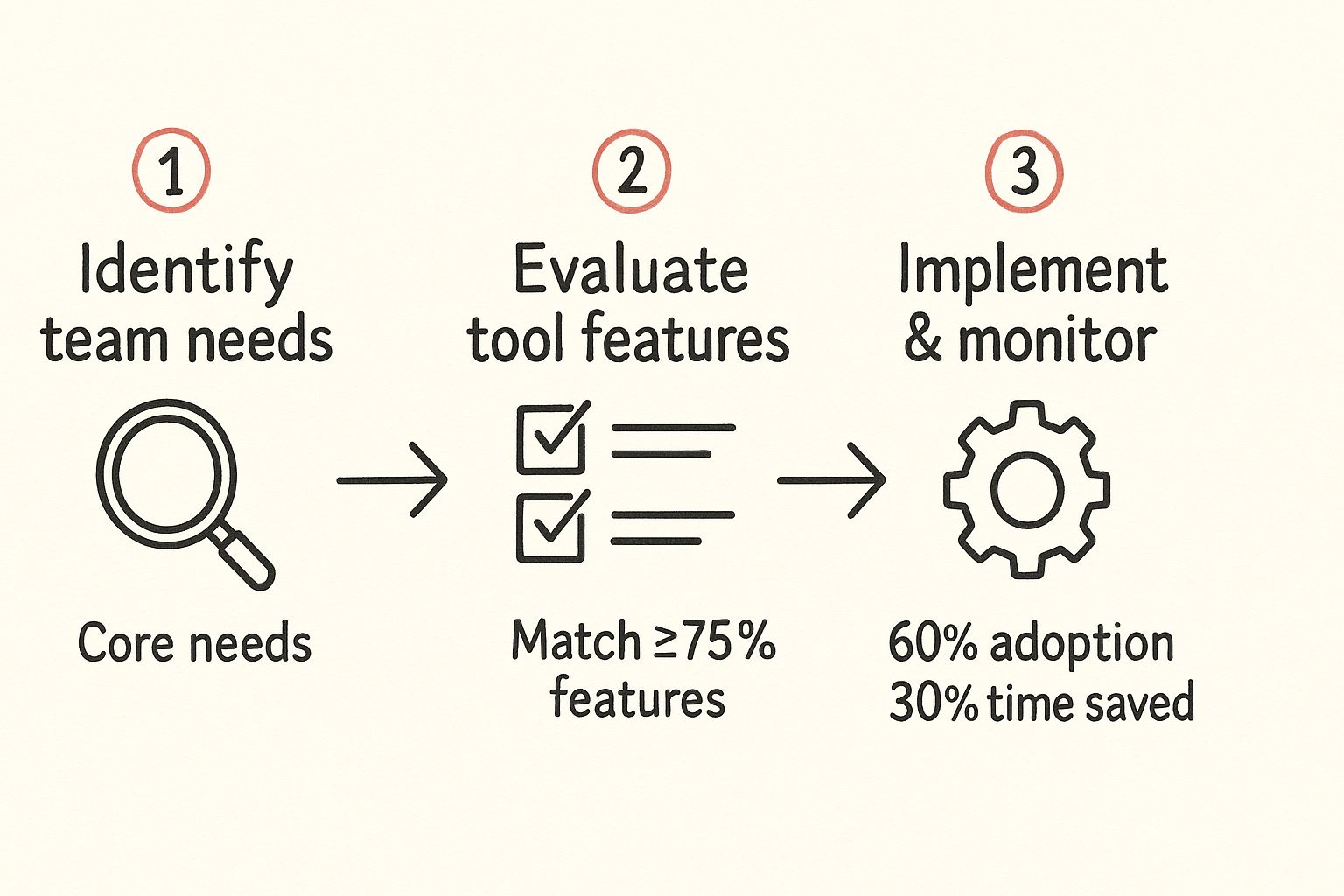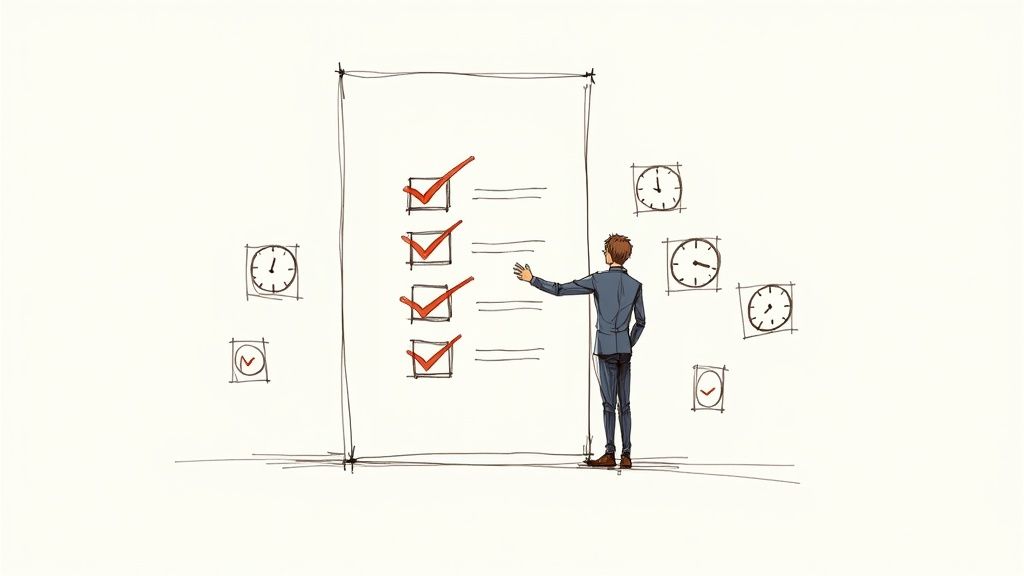How to Improve Team Productivity Without Burning Out
Improving team productivity isn't about logging more hours.We’ve all been there—stuck in a cycle of being busy but not actually getting anything meaningful done. The real win isn't about working harder; it's about building a system where focused, high-impact work can actually happen. It all comes down to a smart mix of clear goals, a team that's genuinely engaged, and the right tech, like Compresto, to glue it all together.
This guide is about moving past the chaos and finding that clarity.
The Modern Productivity Puzzle: What Truly Drives Teams

Let's be honest, the old 'work harder' mantra is officially broken. Too many teams feel like they're spinning their wheels, trapped by a constant stream of digital noise and back-to-back meetings that go nowhere. The problem usually isn’t a lack of effort—it's a lack of focus.
Modern work is a bit of a paradox. Even though the average workday has shrunk by 36 minutes since pre-pandemic times, overall productivity is up by 2%. But that progress is fragile. We’re interrupted by digital pings roughly every three minutes, and it takes an average of 23 minutes to get back on track.
This constant context switching is the silent killer of deep work. Each notification, unplanned call, or "quick question" pulls your team away from what really matters, leaving everyone feeling perpetually behind.
To genuinely boost your team's output, you have to tackle these systemic issues head-on. It's less about individual life hacks and more about building a resilient framework for how you operate.
Before diving into specific tactics, it's helpful to see how these challenges fit into the bigger picture of team productivity. The table below breaks down the core pillars we'll be exploring.
Core Pillars of Modern Team Productivity
| Pillar | Key Challenge | Strategic Solution (Preview) |
|---|---|---|
| Clarity of Purpose | Team members feel disconnected from the "why" behind their tasks, leading to disengagement. | Align daily work with big-picture company goals to give every task clear meaning. |
| Structured Communication | Constant interruptions from scattered chats and emails kill focus and deep work. | Create dedicated, centralized channels for different types of communication. |
| Process Optimization | Inefficient workflows and hidden bottlenecks slow down progress and cause frustration. | Continuously identify and smooth out friction points in your team's daily processes. |
| Empowerment Through Tools | The wrong tech adds complexity instead of solving problems, creating more work. | Equip your team with intuitive tools that genuinely reduce friction and save time. |
This framework gives us a clear roadmap for creating a more focused and effective work environment. Now, let's break down how to build it.
Building Your Productivity Framework
A successful framework isn’t just about adopting a new tool; it's a commitment to a new way of working. It requires a clear strategy that gets to the root of what holds teams back.
Here are the foundational pillars to start with:
-
Clarity of Purpose: Make sure everyone on your team understands not just what they’re doing, but why it matters. When people see how their work contributes to the bigger picture, their engagement skyrockets.
-
Structured Communication: Ditch the scattered chats and endless email threads. Create designated channels for specific conversations inside a central platform. This simple change can dramatically cut down on the noise.
-
Process Optimization: Always be on the lookout for bottlenecks. Where do things get stuck? What takes way too long? Our guide on business process improvement techniques offers some practical ways to start refining your workflows.
-
Empowerment Through Tools: Give your team tech that actually helps. The goal is to reduce friction, not add another layer of complexity. For instance, a tool like Compresto makes file management seamless, saving everyone time on a core task they perform all day long.
By focusing on these areas, you shift the team's energy from just managing tasks to creating an environment where high-impact work becomes the default. This is how you build sustainable momentum and avoid the burnout that comes from an endless cycle of short-term sprints.
Fostering Engagement for Higher Productivity

Let's be honest: productivity isn't a switch you can just flip on. It's the direct result of how engaged your team feels. A disengaged team is the silent killer of deadlines and new ideas, quietly letting small issues snowball into major roadblocks. If you want a truly motivated group, you have to move beyond superficial perks like free pizza.
Real engagement is built on a few core principles. It starts with transparent communication where everyone knows how their work contributes to the bigger picture. It also means consistent, authentic recognition—not just a canned line item in an annual performance review.
Create a Culture of Recognition and Transparency
A team that feels seen and valued will always outperform one that feels like just another cog in the machine. Engagement skyrockets when positive contributions are acknowledged publicly and often. For example, instead of waiting for a monthly all-hands meeting, why not use a shared channel to give an immediate shout-out for a job well done?
This transparency has to apply to challenges, too. When you build a culture where asking for help is seen as a strength, not a weakness, people stop struggling in silence. A huge part of this is improving team collaboration, which is fundamental to success. When people feel safe enough to be vulnerable, they solve problems faster and learn from each other more effectively.
The Financial Impact of an Engaged Team
The connection between engagement and the bottom line isn't just a hunch; it's backed by hard data. Teams with strong employee engagement are significantly more productive. In fact, highly engaged teams can drive up to 21% greater profitability compared to their less engaged peers.
Despite this clear financial upside, a staggering 21% of global employees report being engaged at work. That disconnect is costing the global economy billions. This data drives home a critical point for any leader: investing in your team's engagement delivers a real, measurable return.
Imagine two scenarios. In one, a developer hits a snag but hesitates to ask for help, wasting a full day trying to fix it alone. In the other, an engaged team culture encourages them to post the problem in a shared space. A senior engineer spots it and offers a solution in under an hour. That’s the real-world difference engagement makes.
This is where a central hub for communication, like the project dashboards in Compresto, becomes invaluable. When recognition and feedback are visible parts of the daily workflow, they become ingrained in your culture—not just another HR initiative.
This visibility reinforces positive behaviors and keeps the entire team aligned and motivated. By making achievements and progress transparent, you create a powerful, self-reinforcing loop of engagement and productivity that drives tangible results.
Centralizing Your Workflow to Eliminate Chaos
If your team's tasks are scattered across emails, chat messages, and random spreadsheets, you're constantly fighting a losing battle against context switching. We've all been there. Research shows that just toggling between different apps makes it harder to focus, leading to a massive drop in efficiency.
The only way to win this fight is by creating a single source of truth—one central place where every piece of project information lives. This isn't just about being tidy; it's about reclaiming your team's focus. When everyone knows exactly where to find assignments, updates, and files, they spend less time searching and more time actually doing the work.
This simple shift eliminates the endless "just checking in" messages that kill deep work and frees up a ton of mental space for everyone.
The infographic below breaks down a simple, three-stage process for picking and rolling out a tool to create this central hub.

As you can see, a successful rollout is all about matching the tool to your team's real-world needs and then tracking adoption to make sure you’re getting the promised value.
Setting Up Your Central Hub
Let’s walk through a real-world example. Imagine a marketing team gearing up for a new product launch. In the past, their process was a chaotic mess: a shared drive for assets, a sprawling spreadsheet for deadlines, and a frantic chat channel for approvals. Sound familiar?
To fix this, they decided to map their entire process in a centralized tool like Compresto. Here’s the approach they took:
- Define Clear Roles and Responsibilities: Who has the final say on ad copy? Who’s responsible for uploading the final video files? They assigned specific roles directly within each task, so there was zero confusion about ownership.
- Create a Templated Workflow: They built a pre-made project template for every new campaign. This template included clear phases for brainstorming, content creation, design review, and performance analysis.
- Establish Communication Guidelines: All feedback on creative assets must happen within the task itself—no more side conversations in chat. This keeps every discussion contextual and easy to reference later.
This new structure immediately clarified who was doing what and by when. It transformed a messy, reactive process into a predictable, proactive system. The team stopped losing critical files and missing feedback, a common headache when managing creative projects. If you're dealing with tons of creative files, setting up a dedicated digital asset management workflow can bring even more efficiency.
Migrating Without Losing Momentum
Switching systems can feel like a huge undertaking, but it doesn’t have to derail your current projects. The secret is a phased migration. The marketing team started small by moving just one new, low-priority project into their new system.
This pilot project approach is crucial. It lets the team learn the new tool and workflow in a low-stakes environment. More importantly, it surfaces valuable feedback you can use to refine the process before a full-scale rollout.
This visual layout makes it incredibly easy to see where things stand, spot bottlenecks, and rebalance workloads on the fly—often without needing another status meeting. By bringing everything into one view, you empower your team to manage their own time more effectively and keep the entire project moving forward.
Using Automation and AI to Eliminate Tedious Work
Your team's collective brainpower is their most valuable asset, but so much of it gets eaten up by repetitive, manual tasks. The goal here isn't to bring in futuristic robots to replace people; it's about using practical automation to give them their time back, starting today. When you offload the administrative burden, you free up your team to focus on the strategic, creative work that actually drives growth.
It's all about spotting the small, recurring tasks that quietly steal hours of productivity each week. Think about setting up rules that automatically assign follow-up tasks when a project hits a new stage, or sending automated status reminders to key stakeholders every Friday. These little tweaks make a huge difference in reducing the mental load on your team.
For example, a marketing team could create a simple rule: when a task gets moved to the "Final Review" column, it automatically pings the department head and sets a 24-hour deadline. Just like that, you've eliminated the need for manual emails or Slack messages. It’s a small change that has a big impact on workflow and focus.
Let AI Handle the Busywork
Going beyond simple rule-based automation, artificial intelligence can take on more complex—but equally draining—tasks. Simple AI features baked into modern project management tools can summarize long comment threads, giving a new team member instant context without forcing them to read pages of back-and-forth chatter.
Other AI tools can proactively flag potential risks in a project timeline before they become full-blown problems. Imagine an AI assistant that scans your project board and highlights tasks that are falling behind or points out a team member who is clearly overloaded. This kind of insight allows you to step in early and keep everything on track.
The impact of this technology is hard to ignore. Companies that really lean into AI see real gains—around 72% report higher productivity, and 59% see a boost in job satisfaction.
Practical Automation Examples to Start With
Getting started with automation doesn't have to be a massive undertaking. By focusing on a few high-impact areas, you can see improvements in your team's productivity almost immediately.
Here are a few ideas you can roll out right away:
- Automated Task Assignment: Create rules that assign specific tasks to the right people based on the project type or stage. For instance, all design mockups could be automatically assigned to the lead designer.
- Status Update Reminders: Set up automated messages that gently nudge team members for updates on overdue tasks. This saves managers from having to chase people down.
- Project Board Cleanup: Automatically archive completed tasks after a set period, like 30 days. This keeps your workspace clean and focused only on what's active.
Putting even one of these into practice can create a positive ripple effect across your team. For a deeper look into streamlining these processes, our guide on document workflow automation offers a step-by-step approach to setting up more advanced systems that save time and cut down on errors. By building these efficiencies into your daily operations, you create an environment where your team can truly shine.
Measuring Performance Without Micromanaging
Improving productivity needs a feedback loop, but nobody wants their manager breathing down their neck. The real key is to stop tracking hours and start measuring the flow of work. It’s an approach that respects your team’s autonomy while giving you the insights to make objective, supportive decisions that actually help.
Forget about monitoring activity. You should be tracking outcomes and efficiency. A centralized platform like Compresto is perfect for this because it brings the data to the surface without you having to ask for it. You can see how long projects really take from start to finish, where tasks get stuck, and whether the workload is balanced.
When you have this data, weekly check-ins transform from status interrogations into genuinely productive problem-solving sessions.
Key Metrics That Matter
To measure performance the right way, you need to track the right Key Performance Indicators (KPIs). The best ones focus on the health and speed of your workflow, not on individual busywork. By zeroing in on these, you can spot systemic issues before they blow up a project.
Here are a few essential, non-intrusive metrics I always start with:
- Project Cycle Time: This is the total time from when a task is started until it’s truly done. If your cycle times are consistently long, that’s a huge red flag for hidden bottlenecks or clunky processes.
- Task Completion Rate: Tracking the percentage of tasks finished within a specific timeframe gives you a real sense of your team's capacity. It’s also a lifesaver for forecasting future projects accurately.
- Workload Distribution: This metric shows you if work is spread evenly across the team. It’s absolutely critical for preventing burnout and making sure one person doesn’t become a single point of failure.
Shifting to these flow-based metrics changes the conversation from "Are you busy?" to "What's blocking our progress?" That subtle change empowers your team to own their part of the process and solve problems together, building a culture of continuous improvement.
We can't talk about tracking without mentioning what not to do. It's easy to fall into the trap of vanity metrics that look good on a dashboard but don't tell you anything useful. The goal is to gather data that helps your team, not just monitors them.
Here's a quick look at some key productivity metrics that keep the focus on improvement, not intrusion.
Key Productivity Metrics to Track
This table outlines essential, non-intrusive metrics for measuring team productivity, helping leaders focus on meaningful data.
| Metric | What It Measures | Why It's Important |
|---|---|---|
| Cycle Time | The time it takes for a task to move from "in progress" to "complete." | Highlights bottlenecks and process inefficiencies. Shortening cycle time means faster delivery. |
| Lead Time | The total time from when a task is requested to when it's delivered. | Gives a customer-centric view of your process. It includes wait times, not just active work time. |
| Throughput | The number of tasks completed in a given period (e.g., a week or a sprint). | A great indicator of your team's capacity and velocity. It helps with realistic planning. |
| Work in Progress (WIP) | The number of tasks currently being worked on by the team. | Too much WIP can signal multitasking and context-switching, which kills productivity. |
Focusing on these metrics helps you see the bigger picture of your team's workflow. It’s about understanding the system, not scrutinizing the individual.
A Framework for Troubleshooting Bottlenecks
Data is only useful if you do something with it. When your KPIs point to a problem—say, a recurring bottleneck in the review stage—you need a simple framework to fix it without pointing fingers.
First, identify the pattern. Is one specific person always overloaded? Or does a certain type of task always get stuck? Use the analytics in your project management tool to find the source of the friction.
Next, open a dialogue. Approach the team with the data, not accusations. You could say something like, "I've noticed tasks are slowing down during the design review phase. What are your thoughts on how we can streamline this?" This turns it into a collaborative problem-solving exercise.
Finally, propose and test a solution. Maybe you need to rebalance workloads, simplify a clunky approval process, or bring in some extra help. The goal is to make small, iterative changes based on real data. That’s how you get sustainable productivity gains and a healthier, more balanced team.
Your Path to Sustainable Team Productivity
So, where do we go from here? The most important thing to remember is that lasting team productivity isn't a destination you arrive at. It’s a living, breathing system you build, fine-tune, and nurture over time. We've walked through the essentials: building a culture of engagement, centralizing your work for crystal-clear focus, using smart automation to win back time, and actually measuring what matters so you can improve.
Don't try to boil the ocean. Real, lasting change starts with a single, manageable step.
I’ve seen teams try to change everything at once, and it almost never sticks. The most effective approach is incremental. Start by mapping just one critical process in Compresto or running a small pilot project with your new workflow. This builds momentum and shows people the value right away.
This guide gives you the blueprint for building a more productive, resilient team. Now, it's time to lay the first stone. If you want to dive even deeper into different methods, check out these proven strategies to improve team productivity from a great resource I often recommend.
By taking that first small step, you kick off the process of transforming how your team works together. You're not just chasing short-term wins; you're building a foundation for sustainable success and a healthier way of working.
Frequently Asked Questions

Switching up your team's workflow always brings up a few practical questions. Let's dig into some of the most common things people ask about getting started, managing remote teams, and making sure these new habits actually stick around.
A big one is always getting the team on board. The trick is to avoid making it feel like a top-down mandate. Instead, frame it as a team effort to get rid of frustrating busywork. Find a specific, shared headache—maybe it's the chaotic way you share files or how project handoffs always seem to fall apart—and introduce a new tool or process as the solution.
When your team sees a new system as a way to solve their own daily headaches, adoption happens organically. Focus on the "what's in it for them" by highlighting how it saves time and reduces confusion.
This approach gets people excited instead of resistant, which makes the whole transition a lot smoother.
How Do These Methods Apply to Hybrid Teams?
Making these strategies work for remote or hybrid teams is actually easier than you might think. The core ideas—centralizing everything and communicating clearly—are even more important when you're not all in the same room. A central hub like Compresto makes sure everyone has the same access to information, no matter where they're logging in from.
The data backs this up. Hybrid models, like letting people work from home two days a week, have been shown to keep productivity just as high as fully in-office teams. Plus, it can slash turnover risk by a whopping 33%. You can dive deeper into these employee productivity statistics and see how they're shaping the modern workplace.
This just proves how vital it is to have solid systems that support work happening at different times and in different places. The key is to over-communicate processes and expectations right inside your central platform.
What Is the Best Way to Choose a Tool?
When you're picking a tool to bring your workflow together, it's easy to get lost in endless feature lists. Don't fall into that trap. Instead, laser-focus on what your team actually needs. Does this tool fix your biggest bottleneck? Is it simple enough that your team will use it without needing a week of training?
My advice is to start small. Run a pilot project with just a few team members. Their real-world feedback is worth more than any sales demo you'll ever see. Ultimately, you want a tool that can grow with you, not one that locks you into a super rigid, complicated system from the get-go.
Ready to eliminate file chaos and centralize your team's workflow? Discover how Compresto can help you save time, reduce file sizes, and create a single source of truth for all your important assets. Get started with Compresto today.